Yuwei Zhang
Seedream 3.0 Technical Report
Apr 16, 2025Abstract:We present Seedream 3.0, a high-performance Chinese-English bilingual image generation foundation model. We develop several technical improvements to address existing challenges in Seedream 2.0, including alignment with complicated prompts, fine-grained typography generation, suboptimal visual aesthetics and fidelity, and limited image resolutions. Specifically, the advancements of Seedream 3.0 stem from improvements across the entire pipeline, from data construction to model deployment. At the data stratum, we double the dataset using a defect-aware training paradigm and a dual-axis collaborative data-sampling framework. Furthermore, we adopt several effective techniques such as mixed-resolution training, cross-modality RoPE, representation alignment loss, and resolution-aware timestep sampling in the pre-training phase. During the post-training stage, we utilize diversified aesthetic captions in SFT, and a VLM-based reward model with scaling, thereby achieving outputs that well align with human preferences. Furthermore, Seedream 3.0 pioneers a novel acceleration paradigm. By employing consistent noise expectation and importance-aware timestep sampling, we achieve a 4 to 8 times speedup while maintaining image quality. Seedream 3.0 demonstrates significant improvements over Seedream 2.0: it enhances overall capabilities, in particular for text-rendering in complicated Chinese characters which is important to professional typography generation. In addition, it provides native high-resolution output (up to 2K), allowing it to generate images with high visual quality.
Attention Reveals More Than Tokens: Training-Free Long-Context Reasoning with Attention-guided Retrieval
Mar 12, 2025Abstract:Large Language Models (LLMs) often exhibit substantially shorter effective context lengths than their claimed capacities, especially when handling complex reasoning tasks that require integrating information from multiple parts of a long context and performing multi-step reasoning. Although Chain-of-Thought (CoT) prompting has shown promise in reducing task complexity, our empirical analysis reveals that it does not fully resolve this limitation. Through controlled experiments, we identify poor recall of implicit facts as the primary cause of failure, which significantly hampers reasoning performance. Interestingly, we observe that the internal attention weights from the generated CoT tokens can effectively ground implicit facts, even when these facts are not explicitly recalled. Building on this insight, we propose a novel training-free algorithm, Attrieval, which leverages attention weights to retrieve relevant facts from the long context and incorporates them into the reasoning process. Additionally, we find that selecting context tokens from CoT tokens further improves performance. Our results demonstrate that Attrieval enhances long-context reasoning capability notably on both synthetic and real-world QA datasets with various models.
Seedream 2.0: A Native Chinese-English Bilingual Image Generation Foundation Model
Mar 10, 2025Abstract:Rapid advancement of diffusion models has catalyzed remarkable progress in the field of image generation. However, prevalent models such as Flux, SD3.5 and Midjourney, still grapple with issues like model bias, limited text rendering capabilities, and insufficient understanding of Chinese cultural nuances. To address these limitations, we present Seedream 2.0, a native Chinese-English bilingual image generation foundation model that excels across diverse dimensions, which adeptly manages text prompt in both Chinese and English, supporting bilingual image generation and text rendering. We develop a powerful data system that facilitates knowledge integration, and a caption system that balances the accuracy and richness for image description. Particularly, Seedream is integrated with a self-developed bilingual large language model as a text encoder, allowing it to learn native knowledge directly from massive data. This enable it to generate high-fidelity images with accurate cultural nuances and aesthetic expressions described in either Chinese or English. Beside, Glyph-Aligned ByT5 is applied for flexible character-level text rendering, while a Scaled ROPE generalizes well to untrained resolutions. Multi-phase post-training optimizations, including SFT and RLHF iterations, further improve the overall capability. Through extensive experimentation, we demonstrate that Seedream 2.0 achieves state-of-the-art performance across multiple aspects, including prompt-following, aesthetics, text rendering, and structural correctness. Furthermore, Seedream 2.0 has been optimized through multiple RLHF iterations to closely align its output with human preferences, as revealed by its outstanding ELO score. In addition, it can be readily adapted to an instruction-based image editing model, such as SeedEdit, with strong editing capability that balances instruction-following and image consistency.
Toward Multi-Session Personalized Conversation: A Large-Scale Dataset and Hierarchical Tree Framework for Implicit Reasoning
Mar 10, 2025Abstract:There has been a surge in the use of large language models (LLM) conversational agents to generate responses based on long-term history from multiple sessions. However, existing long-term open-domain dialogue datasets lack complex, real-world personalization and fail to capture implicit reasoning-where relevant information is embedded in subtle, syntactic, or semantically distant connections rather than explicit statements. In such cases, traditional retrieval methods fail to capture relevant context, and long-context modeling also becomes inefficient due to numerous complicated persona-related details. To address this gap, we introduce ImplexConv, a large-scale long-term dataset with 2,500 examples, each containing approximately 100 conversation sessions, designed to study implicit reasoning in personalized dialogues. Additionally, we propose TaciTree, a novel hierarchical tree framework that structures conversation history into multiple levels of summarization. Instead of brute-force searching all data, TaciTree enables an efficient, level-based retrieval process where models refine their search by progressively selecting relevant details. Our experiments demonstrate that TaciTree significantly improves the ability of LLMs to reason over long-term conversations with implicit contextual dependencies.
Object Detection for Medical Image Analysis: Insights from the RT-DETR Model
Jan 27, 2025



Abstract:Deep learning has emerged as a transformative approach for solving complex pattern recognition and object detection challenges. This paper focuses on the application of a novel detection framework based on the RT-DETR model for analyzing intricate image data, particularly in areas such as diabetic retinopathy detection. Diabetic retinopathy, a leading cause of vision loss globally, requires accurate and efficient image analysis to identify early-stage lesions. The proposed RT-DETR model, built on a Transformer-based architecture, excels at processing high-dimensional and complex visual data with enhanced robustness and accuracy. Comparative evaluations with models such as YOLOv5, YOLOv8, SSD, and DETR demonstrate that RT-DETR achieves superior performance across precision, recall, mAP50, and mAP50-95 metrics, particularly in detecting small-scale objects and densely packed targets. This study underscores the potential of Transformer-based models like RT-DETR for advancing object detection tasks, offering promising applications in medical imaging and beyond.
LongMemEval: Benchmarking Chat Assistants on Long-Term Interactive Memory
Oct 14, 2024



Abstract:Recent large language model (LLM)-driven chat assistant systems have integrated memory components to track user-assistant chat histories, enabling more accurate and personalized responses. However, their long-term memory capabilities in sustained interactions remain underexplored. This paper introduces LongMemEval, a comprehensive benchmark designed to evaluate five core long-term memory abilities of chat assistants: information extraction, multi-session reasoning, temporal reasoning, knowledge updates, and abstention. With 500 meticulously curated questions embedded within freely scalable user-assistant chat histories, LongMemEval presents a significant challenge to existing long-term memory systems, with commercial chat assistants and long-context LLMs showing 30% accuracy drop on memorizing information across sustained interactions. We then present a unified framework that breaks down the long-term memory design into four design choices across the indexing, retrieval, and reading stages. Built upon key experimental insights, we propose several memory designs including session decomposition for optimizing value granularity, fact-augmented key expansion for enhancing the index structure, and time-aware query expansion for refining the search scope. Experiment results show that these optimizations greatly improve both memory recall and downstream question answering on LongMemEval. Overall, our study provides valuable resources and guidance for advancing the long-term memory capabilities of LLM-based chat assistants, paving the way toward more personalized and reliable conversational AI.
RespLLM: Unifying Audio and Text with Multimodal LLMs for Generalized Respiratory Health Prediction
Oct 07, 2024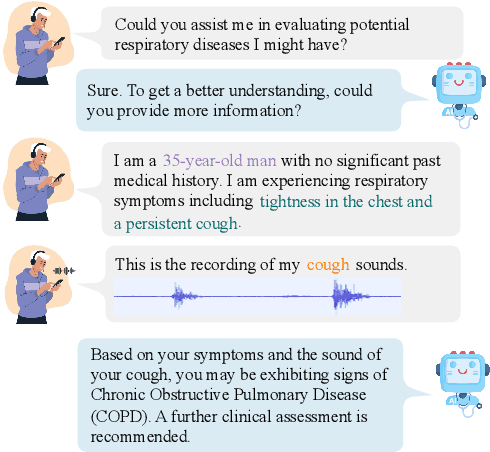
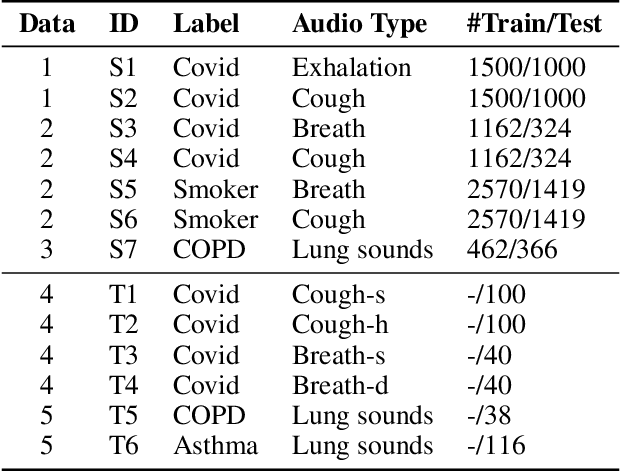
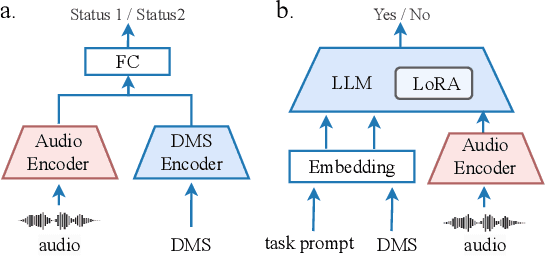

Abstract:The high incidence and mortality rates associated with respiratory diseases underscores the importance of early screening. Machine learning models can automate clinical consultations and auscultation, offering vital support in this area. However, the data involved, spanning demographics, medical history, symptoms, and respiratory audio, are heterogeneous and complex. Existing approaches are insufficient and lack generalizability, as they typically rely on limited training data, basic fusion techniques, and task-specific models. In this paper, we propose RespLLM, a novel multimodal large language model (LLM) framework that unifies text and audio representations for respiratory health prediction. RespLLM leverages the extensive prior knowledge of pretrained LLMs and enables effective audio-text fusion through cross-modal attentions. Instruction tuning is employed to integrate diverse data from multiple sources, ensuring generalizability and versatility of the model. Experiments on five real-world datasets demonstrate that RespLLM outperforms leading baselines by an average of 4.6% on trained tasks, 7.9% on unseen datasets, and facilitates zero-shot predictions for new tasks. Our work lays the foundation for multimodal models that can perceive, listen to, and understand heterogeneous data, paving the way for scalable respiratory health diagnosis.
Jump Diffusion-Informed Neural Networks with Transfer Learning for Accurate American Option Pricing under Data Scarcity
Sep 26, 2024Abstract:Option pricing models, essential in financial mathematics and risk management, have been extensively studied and recently advanced by AI methodologies. However, American option pricing remains challenging due to the complexity of determining optimal exercise times and modeling non-linear payoffs resulting from stochastic paths. Moreover, the prevalent use of the Black-Scholes formula in hybrid models fails to accurately capture the discontinuity in the price process, limiting model performance, especially under scarce data conditions. To address these issues, this study presents a comprehensive framework for American option pricing consisting of six interrelated modules, which combine nonlinear optimization algorithms, analytical and numerical models, and neural networks to improve pricing performance. Additionally, to handle the scarce data challenge, this framework integrates the transfer learning through numerical data augmentation and a physically constrained, jump diffusion process-informed neural network to capture the leptokurtosis of the log return distribution. To increase training efficiency, a warm-up period using Bayesian optimization is designed to provide optimal data loss and physical loss coefficients. Experimental results of six case studies demonstrate the accuracy, convergence, physical effectiveness, and generalization of the framework. Moreover, the proposed model shows superior performance in pricing deep out-of-the-money options.
Non-stationary BERT: Exploring Augmented IMU Data For Robust Human Activity Recognition
Sep 25, 2024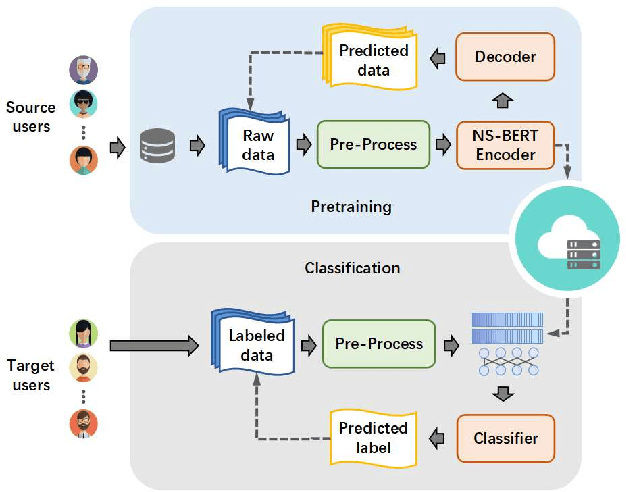
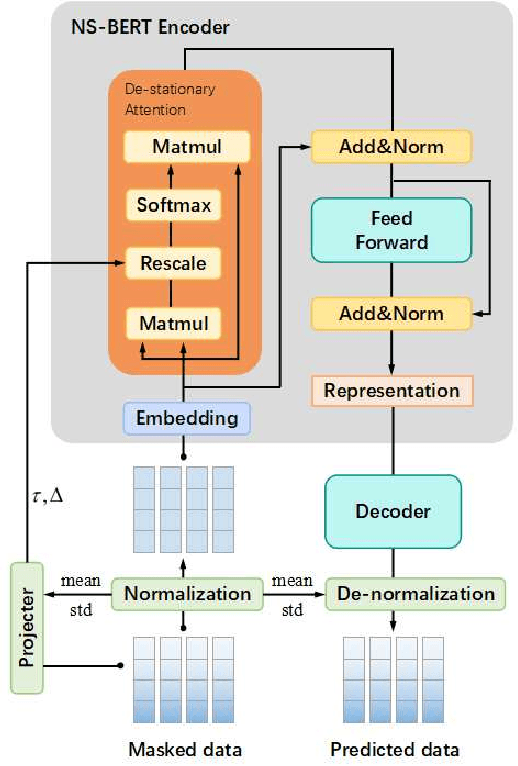
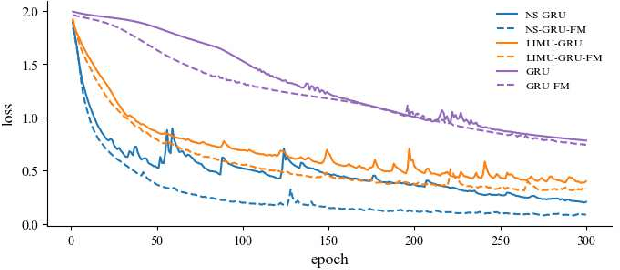

Abstract:Human Activity Recognition (HAR) has gained great attention from researchers due to the popularity of mobile devices and the need to observe users' daily activity data for better human-computer interaction. In this work, we collect a human activity recognition dataset called OPPOHAR consisting of phone IMU data. To facilitate the employment of HAR system in mobile phone and to achieve user-specific activity recognition, we propose a novel light-weight network called Non-stationary BERT with a two-stage training method. We also propose a simple yet effective data augmentation method to explore the deeper relationship between the accelerator and gyroscope data from the IMU. The network achieves the state-of-the-art performance testing on various activity recognition datasets and the data augmentation method demonstrates its wide applicability.
Attention Mechanism and Context Modeling System for Text Mining Machine Translation
Aug 08, 2024



Abstract:This paper advances a novel architectural schema anchored upon the Transformer paradigm and innovatively amalgamates the K-means categorization algorithm to augment the contextual apprehension capabilities of the schema. The transformer model performs well in machine translation tasks due to its parallel computing power and multi-head attention mechanism. However, it may encounter contextual ambiguity or ignore local features when dealing with highly complex language structures. To circumvent this constraint, this exposition incorporates the K-Means algorithm, which is used to stratify the lexis and idioms of the input textual matter, thereby facilitating superior identification and preservation of the local structure and contextual intelligence of the language. The advantage of this combination is that K-Means can automatically discover the topic or concept regions in the text, which may be directly related to translation quality. Consequently, the schema contrived herein enlists K-Means as a preparatory phase antecedent to the Transformer and recalibrates the multi-head attention weights to assist in the discrimination of lexis and idioms bearing analogous semantics or functionalities. This ensures the schema accords heightened regard to the contextual intelligence embodied by these clusters during the training phase, rather than merely focusing on locational intelligence.
 Add to Chrome
Add to Chrome Add to Firefox
Add to Firefox Add to Edge
Add to Edge